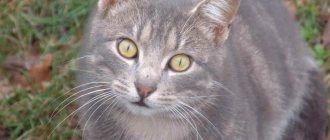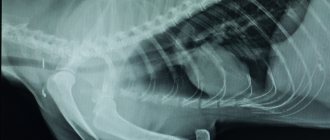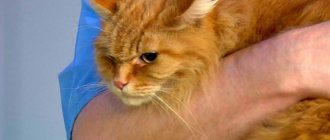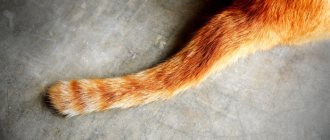15892Administration
If a cat poops with blood, in most cases this is really a reason to urgently contact a veterinarian. This phenomenon usually indicates serious problems in the pet’s health.
Extravasates (blood clots) in a cat’s feces should be absent during normal functioning of the digestive tract, so the owners should not ignore their appearance. However, it happens that if a cat poops with blood, then this is not at all a symptom of a serious illness, but only when such a case is one-time, and not repeated from time to time.
© shutterstock
Warning signs and symptoms
When cleaning up the pet's potty, the owner may discover that there are several drops of blood on the feces, or that the entire mass of feces is colored reddish. Let us note right away that this is not normal, and such a signal indicates that the animal needs increased observation and attention from humans.
If blood was detected in the stool of a furry pet once, the symptom did not recur again, and the general condition of the animal is assessed as good (that is, the pet is cheerful, cheerful, eats, actively responds to affection), there is no need to worry. Most likely, there was a one-time injury to the animal’s rectum (for example, the mucous membrane could have been scratched by a sharp piece of undigested food or a small foreign object that came out naturally).
The general condition of the cat is an indicator of health
If blood appears in the stool again and again, you need to find out the reason for its appearance immediately. In a situation where bloody spots in the animal’s feces are accompanied by such manifestations as lethargy or lethargy of the pet, diarrhea or constipation, refusal to eat, increased or decreased body temperature (the norm for an adult cat is within 38-39 degrees), you need to take the pet to the clinic immediately.
The severity of the problem at the initial stage can be assessed by the owner himself. You need to make an appointment at the veterinary clinic on the same day if your cat has the following problems:
- The bleeding is profuse (not streaks or droplets, but whole puddles).
- Blood flows from the anus even when not having a bowel movement.
- The animal screams on the potty, showing pain.
- The cat is vomiting.
If the cat wants to go to the toilet, but cannot, the problem requires the intervention of a doctor.
It is not at all necessary (and even impossible) that all of these symptoms will appear simultaneously. The manifestation of at least one of them, together with the blood that appears in the tray, is enough to show the pet to a qualified veterinarian. It is worth remembering that bleeding from the anus can cause the death of a cat quite quickly!
Important! If the listed symptoms are observed not in an adult animal, but in a kitten, you need to act very quickly. Due to the kitten’s fragile body and shaky immunity, the signs mentioned above can become fatal.
Apathy and refusal to eat are the first alarming symptoms
When to take your pet to the doctor
You should contact your veterinarian in the following cases::
- This is not the first time that scarlet blood has appeared in the cat’s stool, and its amount is clearly more than a drop;
- the cat meows or howls when defecating;
- during the process of defecation, the animal is clearly tense; it is impossible to poop without pushing;
- The pet often goes to the toilet to poop (normally – 1-2 times a day).
These manifestations are often accompanied by additional symptoms:
- decreased appetite;
- diarrhea with vomiting;
- increased frequency of urination;
- lethargy, apathetic mood of the pet;
- pronounced thirst;
- sudden weight loss;
- the cat runs its butt on the carpets (a sign of problems with the anal sinuses).
With these signs, you also need to observe how many times a day the cat walks around, how often there is blood and how much of it, whether there are other foreign impurities (mucus, remains of fur or undigested food, etc.). You also need to pay attention to the cat’s behavior and mood, how he eats, how much he drinks, whether there is vomiting and fever. You will need to tell the veterinarian about all this when your pet comes in for an appointment. This will help speed up diagnosis and initiation of treatment.
© shutterstock
Additional symptoms
Blood in a cat's stool is often not the only symptom. If the cause of bloody stool is an infectious disease or the appearance of neoplasms in the gastrointestinal tract, then your pet will have other accompanying signs.
Among them:
- sudden weight loss,
- vomit,
- diarrhea,
- strong thirst
- sluggish and apathetic state,
- frequent urination (pay attention to the urine: it may also contain small amounts of blood),
- pain in the abdominal area.
Are you observing one or more signs in your pet? Don't hesitate - seek help from a professional veterinarian. He will give the cat an accurate diagnosis and prescribe effective treatment for the disease.
Causes of blood in stool
The first thing you need to pay attention to is the appearance of the blood. If it is fresh, this indicates that the bleeding began near the anus (for example, the anal sphincter is injured) or in the large intestine.
We draw your attention to the most common reasons why your cat goes to the toilet with blood:
- Eating disorder
- Parasites
- Gastrointestinal diseases
- Foreign bodies
- Neoplasms
- Dysbacteriosis
- Bleeding disorders
- Poisoning with toxic substances
If your pet's diet consists of low-quality dry food, its particles can injure the mucous membranes of the stomach. The likelihood of injury increases if the cat drinks little water. Dry food does not soak, and its sharp ends injure the stomach.
Worms, Giardia, coccidia and other helminths (protozoa) increase capillary permeability and injure the mucous membranes of the stomach. As a result, blood is mixed with the stool, but its volume depends on the number of parasites in the body.
Acute pancreatitis, liver dystrophy, chronic colitis and enteritis are just some of the diseases of the gastrointestinal tract that can cause the appearance of blood clots in the stool. If with an ulcer blood impurities are very noticeable, then with other diseases they are practically invisible.
Most often they enter the gastrointestinal tract during eating or drinking. Foreign objects (for example, pieces of plastic, bones) damage the integrity of soft tissues or cause constipation, in which solid feces slowly pass through the intestines, causing injury.
Passing through the intestine with malignant or benign neoplasms, feces encounter growths. The result is damage to the mucous membranes and the formation of blood impurities in the cat’s stool.
Intestinal bloating, heaviness and grumbling, as well as blood impurities in the stool - these signs are characteristic of dysbiosis that occurs when consuming low-quality or expired products (for example, spoiled milk or sour cream).
If your cat has problems with blood clotting (for example, a deficiency of vitamin K or prothrombin in the body), then even a minor injury can lead to severe bleeding.
Krysid, zoocoumarin and other poisons intended for rodents act on the principle of coagulants. By eating them, the cat's blood clotting is impaired, so a lot of blood appears in the feces. The only way to save your pet is to immediately contact a veterinarian.
What to do if a kitten or pregnant cat has blood in the stool
Waiting until blood appears in the stool of a pregnant cat or very young kittens is unacceptable. The animal must be examined by a veterinarian, preferably at home. Blood in the stool of kittens most often indicates an infectious disease, as well as errors in the diet during weaning or food intolerance. Blood in a pregnant cat's stool may be bloody discharge from the uterus.
Prescription of medications is carried out only by a veterinarian, since, for example, the use of anthelmintics, which are acceptable during pregnancy in cats, may be unacceptable in this particular individual if it has other contraindications. In severe cases, the prospect of continuing pregnancy, as well as breastfeeding, is assessed only by a veterinarian, since these conditions greatly limit therapeutic options. Therefore, it is important to vaccinate and worm your cat before pregnancy.
Where to go for veterinary help if you find blood in your kitten's stool
To normalize stool in kittens as soon as possible
, you can and should seek help from a veterinarian who has sufficient experience in practice.
Among other things, you should pay attention to the laboratory
in which all research is carried out.
The equipment must be the most modern, and the personnel themselves must be only professionals of the highest category. All this is available at the veterinary. This veterinary clinic has opened its doors wide to visitors in every area so that the owners of any animal can receive help at any time. This is especially convenient for the working segment of the population, which simply does not fall into the classic working hours, since at this time they themselves are busy. Also, another advantage of our veterinary center is a very popular service - a veterinarian visiting your home .
This service will help those owners who find themselves in a difficult situation. For example, a pet has diarrhea with blood and in this condition it is simply dangerous to transport it to another place, since due to stress this condition can only worsen
.
At the same time, a comfortable home environment will only contribute to the recovery of your pet
. It has been scientifically proven that staying at home helps recovery no less than the most sophisticated equipment. Also, before getting a job, our employees undergo the most stringent selection; we select only the most worthy candidates who truly love animals and are ready to work with them.
Veterinarians work around the clock, this makes the appointment as convenient and comfortable as possible for the vast majority. Thanks to the fact that rare professional doctors have gathered within the walls of the veterinary center, we can help everyone who needs it.
And the following gurus in their field have gathered with us.
- Veterinarians ready to help 24 hours 7 days a week:
- gastroenterologists;
- dentists of the highest qualification;
- dermatologists;
- ENT specialists;
- ratologists;
- nephrologists;
- neurologists;
- otolaryngologists (avian specialist);
- Ultrasound is a specialist who will help both to notice a dangerous tumor and to see the kittens that are in the cat’s stomach.
All these and many other doctors will help make the animal’s treatment comfortable and enjoyable, and if you do not have any health problems, you can get your friend in order by seeking help from a cozy grooming center, which is located very close by.
What to do before visiting a doctor?
If the animal's condition and behavior are satisfactory, and there are no accompanying symptoms or they do not cause concern (for example, one-time diarrhea or constipation against the background of general health), the cat owner can take some actions before going to the veterinary hospital.
These measures include:
- Treating the animal against intestinal parasites (deworming). To do this, you need to purchase a specialized drug with an extended spectrum of action from a pet store and give it to the animal according to the instructions. If dead parasites appear in the cat’s feces within 24 hours, deworming is carried out again after ten days, monitoring the pet’s condition.
- Normalization of diet. The cat needs to be switched to a balanced diet; the easiest way to do this is to opt for ready-made dry food of the “holistic” class. They will provide the animal with all the necessary substances and elements; in addition, such food is hypoallergenic and safe.
- For long-haired cats – cleansing the intestines of hairballs. To help your pet get rid of them, it is enough to purchase a special paste. You can consult with the seller at the pet store. The paste is given to the animal according to the instructions, usually on an empty stomach (a couple of hours before feeding) twice a week.
How to protect your cat from hairballs?
If these recommendations do not work, and blood continues to appear in the cat’s litter box during bowel movements, you should not delay your visit to the clinic. The veterinarian, after listening to the complaints, will carry out the necessary diagnostic procedures to identify the cause of the alarming symptom.
Holistic food for cats
Causes of bloody diarrhea
Liquid stool with blood in an animal can be caused by various reasons. The most common ones :
- Poisoning . A pet can be poisoned by low-quality food or household chemicals, so you need to carefully monitor the cat’s diet and store household substances in places where the animal does not have access;
- Allergic reaction . Bloody diarrhea in an allergic cat is not uncommon. Due to the special sensitivity of the animal’s body to certain substances, blood may appear in the cat’s loose stool;
- Viral and bacterial infections . Viruses cause stomach upset, which is accompanied by blood;
- Presence of internal parasites . Your cat may have roundworms, lamblia, coccidia, which cause bloody diarrhea;
- Hair balls . After hygiene procedures, cats have a lot of fur left in their stomachs, which leaves the body through vomiting. This is a very common occurrence in pets. However, if for some reason not all the fur comes out with vomiting, the cat’s stomach becomes clogged, after which the animal can experience diarrhea with blood;
- Side effects from medications . Medications can upset your cat's stomach.
© shutterstock
Diagnosis of the condition
A pet with a characteristic symptom should be shown to a veterinarian who, after a clinical examination, will prescribe certain diagnostic methods. First of all, the doctor will conduct a detailed blood test, stool examination for helminths, protozoa, and occult blood.
An informative research method is the coprogram. Using this laboratory method, you can find out not only the microscopic composition, but also detect hidden blood in the feces of an animal. If necessary, a urine test will be performed. An ultrasound or X-ray examination of the abdominal organs, as well as a colonoscopy, can be used to find out why a cat poops blood.
How to accurately diagnose the disease?
The owner of a cat that poops blood should be prepared for the veterinarian to ask a number of questions. Typically, a standard medical history includes obtaining the following information from the pet owner:
- The cat’s diet, changes in it recently, compliance with the water regime.
- Date of treatment for parasites and name of the drug.
- Associated symptoms (diarrhea, constipation, itching in the anus, increased attention of the cat to this area, etc.).
- Substances and objects that are dangerous to the cat are in the public domain (poisonous plants in the house, household chemicals, trash cans).
- Does the animal have free access to the street?
Cats walking unattended can get injured or poisoned on the street
To identify the reason why there are traces of blood in a cat's feces, a simple examination is not enough in most situations. Usually, veterinarians first prescribe routine tests: general and detailed (biochemistry) tests of blood, urine and feces samples, ultrasound of the abdominal cavity, x-ray examination of the stomach or intestines, colonoscopy.
If these diagnostic methods do not produce results, then they resort to a biopsy - using an endoscope or during surgery, a section of intestinal tissue is taken for analysis. This method allows you to detect neoplasms or chronic severe inflammation (colitis) in the intestines. Note that this technique is rarely resorted to, because the diagnosis is often clear already in the first stages of examining the animal.
Ultrasound of the peritoneum is painless for a cat
Signs of bleeding in cat stool: hematochezia and melena
Cat feces normally have a uniform structure and fairly dense consistency, cylindrical shape and brown color. They are characterized by a specific mild odor. Milk-fed kittens have lighter-colored excrement and a softer consistency than adult cats.
The phenomenon in which unchanged blood or traces of it are found in the stool is called hematochezia. Hematochezia is a symptom of a disease that causes bleeding into the lumen of the cat's digestive system. Typically, hematochezia indicates lesions in the sections following the stomach and duodenum.
Hematochezia is a pathology of the lower intestine of a cat, characterized by the presence of bloody traces in the feces
When the source of bleeding is located in the stomach or duodenum, the color of the stool becomes black and tarry. This phenomenon is called melena. The black color of blood is obtained from the action of the digestive enzymes of these organs on it. The consistency of stool during melena is usually liquid or semi-liquid, and a sharp unpleasant odor is also characteristic.
Melena is a black, semi-liquid stool with a characteristic unpleasant odor, formed from the blood under the influence of the contents of the stomach and intestines.
Reasons why blood appears in a kitten's stool
First
and the most common
cause of bloody traces in the stool may be ordinary constipation , which, in mild forms, can be treated with a couple of tablespoons of vegetable oil
.
However, this method can be dangerous for the kitten if it has an intestinal obstruction. This diagnosis should be made exclusively by a veterinarian after a comprehensive examination
.
Also the cause of the appearance of blood in feces, the possibility of infection by parasites , which can actively multiply in the intestines, should not be excluded. Cats are big clean people, and therefore they actively lick themselves, putting their fur in order. Often this can also lead to constipation - the hair gets stuck in the intestines and cannot come out on its own.
One of the reasons may be pancreatitis or ulcerative colitis , but these diseases can be identified only after various studies carried out by a veterinarian. Another cause of diarrhea can be inappropriate diet . It is quite possible that the owners generously sprinkle dry food, but completely forget about water and other sources of moisture. This can also lead to constipation. However, the symptom of blood in the stool treated carefully, while paying attention to the consistency of the stool and its smell , which can also tell a lot.
Among other things, cats, like dogs, need the prevention of worms, namely deworming, because it is these unfortunate organisms that can sometimes cause terrible suffering for a small animal.
What treatment is prescribed if a cat poops blood?
Therapy, of course, can be prescribed only after the cause has been established and the veterinarian understands exactly why the cat is pooping blood. In most cases, treatment can be carried out at home, and only if the cat is in serious condition, it is left in the clinic for an inpatient stay until stabilization.
Table 2. Treatment plan for different diagnoses
| Diagnosis | Treatment |
| Diseases of the liver, pancreas | Preparations containing enzymes (Creon, Pancreatin). |
| Allergies, dysbiosis, colitis | Prescription of a veterinary diet (special dry food as recommended by a doctor), probiotic preparations (Zoonorm, Enterol, Bifitrilak, Subtilis), antihistamines (Tavegil, Suprastin). |
| Parasitic infestation | Anthelmintic drugs (Drontal, Dirofen, Mibelmax, Kanikvantel). |
| Intestinal injuries and damage | Vitamin K, drugs that stop bleeding (Dition, Vikasol, Etamzilan). |
| Infections, viruses, bacterial diseases | Complex therapy, including treatment with Fosprenil, Gamavit, Aminovit, Vitafel and similar agents. |
| Foreign body in the intestines, formations. | They require surgical intervention and further rehabilitation. |
The dosage and frequency of taking medications should be prescribed by a veterinarian.
Therapy is often supplemented by changing the animal’s diet. During the animal’s recovery period, the doctor may prescribe feeding with a special veterinary food (for example, “Recovery” from Royal Canin), or recommend changes to the natural diet.
So, the animal should be fed with lean fresh meat (turkey, rabbit, veal), boiled sea fish, offered vegetables, lactic acid products (kefir, white yogurt, yogurt). Milk, spicy, fatty and sweet foods, and foods that cause bloating and gas formation should be strictly excluded from the diet. The cat should have access to clean drinking water around the clock, and daily portions should be fed four to six times a day, little by little.
Water balance is extremely important for the proper formation of cat stool.
Blood in kitten's stool. In what cases should you immediately seek veterinary help?
Diarrhea in a kitten is an extremely dangerous thing. After all, an unformed lump can very quickly die from dehydration. You should also pay attention to the following signs:
- When this symptom appears, you should also pay attention to the following signs:
- a lot of blood in the feces;
- spotting occurs between your pet’s trips to the toilet;
- the kitten loses weight very quickly;
- he drinks a lot;
- severe stomach upset began.
If you notice any of these signs
– should?
a veterinarian at home as soon as possible . This is an ideal solution when the pet is already frightened by what is happening, but is being taken somewhere else. A doctor's home visit will help minimize your pet's stress to a greater extent.
The kitten has blood in its stool - what should I do?
What should be the treatment for diarrhea in a kitten at home ? And what not to do if
Was there
any bloody stool seen ?
- First of all, make sure that the animal has free access and unlimited quantities of water. This measure will help avoid dehydration.
- When the cat lies down to rest, thoroughly clean the floors in the house, paying special attention to the areas under the sofa, this will help prevent poisoning.
- Until the animal recovers completely, play with it carefully and only when it wants it.
- With diarrhea, the stool may also change color. Be sure to pay attention to this. The normal color of stool is dark brown.
Remember that when a kitten has diarrhea, everything matters. Even the color of feces, even their quantity. By providing this information when calling a veterinarian, you can receive better veterinary care. It is possible that the doctor will prescribe some additional tests and studies. You shouldn't give this up. Maybe a classic blood or urine test will help prescribe adequate treatment, which will lead to a speedy recovery for the cat.
Treatment of diarrhea in a kitten. How is it carried out?
How is diarrhea ? First of all, the doctor should prescribe any drug that will help prevent dehydration of the kitten’s body and quickly bring the salt balance back to normal. This medicine must be taken for at least a week to restore normal fluid balance. The doctor will also provide adequate nutrition.
, which will help
restore normal stool - enveloping porridge, will tell you what fish to feed, what to give, and what is best to remove before recovery.
Reasons for negative manifestations
Vomiting blood in a cat: reasons, what to do
Droplets or streaks of blood in the stool may appear as a result of cancer, poor nutrition, the development of an infectious pathology, or infection with parasites. In order to make a preliminary diagnosis, the veterinarian needs to know about the accompanying symptoms, including the frequency of the animal’s visits to the tray, the volume and consistency of the masses after defecation.
Helminthiasis is the cause of blood
Parasites that attach to the walls of the rectum or intestines damage the mucous membrane and contribute to the destruction of capillaries. As the feces move, they provoke the appearance of small wounds, and small bloody streaks appear in the stool. The long course of the pathology is accompanied by increased fatigue and loss of appetite.
The long course of the pathology is accompanied by increased fatigue and loss of appetite
Chronic colitis
Regular digestive problems cause a pronounced deterioration in the animal’s condition, a decrease in its appetite and the frequent appearance of bloody discharge in the feces. Colitis is provoked by an inflammatory process and is accompanied by a moderate pain syndrome, so a concomitant symptom is the animal’s refusal to caress the owner and a negative reaction to attempts to palpate the tummy.
Chronic constipation
Poor nutrition, mainly cereals or baked goods, as well as a lack of water with regular consumption of dry food, can provoke the development of constipation.
Stagnation causes the onset of the inflammatory process. Then, if the cat wants to poop, he has to push hard, creating additional stress on the vascular system, which provokes bleeding. It can worsen when dry feces containing pieces of tubular bones move through the intestines, which can damage not only the mucous membrane, but also the tissue underneath it.
If the menu is incorrect and there is a lack of drinking water, the cat may develop constipation.
Reasons for appearance
There are several of them, and blood in the stool can be caused by various diseases and conditions, among the main ones are:
- Parasites. Helminths adhere to the intestinal walls, damaging them, which causes the appearance of bloody discharge with feces. The stool takes on a brown tint.
- Hard feces (constipation) when passing through the intestines can lead to injury.
- Foreign body, for example, a piece of plastic, tubular bone, etc. During a peristaltic wave passing through the intestines, it begins to move, injuring the surrounding tissues, as a result of which blood appears in the animal’s feces.
- Poisoning, for example, with rat poison. If your pet catches rats, mice, or the house has recently been treated for them, the animal may accidentally eat some of it. Once absorbed, the toxic substance leads to poisoning of the body, which is accompanied by bleeding in the gastrointestinal tract and the pet defecates with blood.
- Malignant and benign tumors, as well as the growth of their metastases with germination into the digestive organs.
- Inflammation of the perianal glands (located in the anus area of cats and used to mark territory). With this disease, they increase due to edema, which can develop into a fistula. During the act of defecation, trauma to the inflamed gland occurs and drops of blood appear.
- Coronavirus infection. This virus leads to the development of gastroenteritis, enteritis and peritonitis. As a result of the development of these diseases, damage to the intestinal mucosa occurs and, as a result, diarrhea with blood, vomiting and other signs of the disease. Young animals under 3 years of age and older animals over 10 years of age are most susceptible to infection. Coronavirus infection is a common cause of death for pets; 90% of those infected die. This is a serious condition that requires immediate veterinary attention.
- Problems with the blood clotting system, which leads to intestinal bleeding. In this case, not only feces interspersed with blood appears, but also vomiting with it. This condition can be dangerous for the animal and requires urgent veterinary attention.
- Colitis. Older animals are most susceptible to this problem. The stool changes not only its color, but also its smell. Along with the feces, dark-colored blood and mucus are released, and constipation alternates with diarrhea.
- Poor absorption of dry food. This is often due to the fact that the animal drinks little water after eating such food, which leads to severe compaction of feces, which injure the delicate intestinal mucosa.
- Various diseases of the gastrointestinal tract. Among the main ones are: gastritis, pancreatitis, cholecystitis, peptic ulcer of the duodenum and stomach and many others. With these diseases, the blood in the feces will be dark, even black, in color.
- Long-term constipation leads to the formation of cracks in the anus, and blood is released in scarlet color at the end of the act of defecation.
- Polyps in the colon lead to trauma and bleeding.
- Allergy to stabilizers, dyes and corn flour contained in dry food. The main recommendation for this condition is a partial or complete transition to separately prepared natural food.
- Infection with bacteria, such as salmonella, colibacteria and intestinal tuberculosis. In this case, inflammation of the intestinal mucosa occurs, the permeability of the vessels located in it increases and, as a result, the detection of blood in the cat’s stool.
- Rectal prolapse caused by prolonged labor, constipation or diarrhea due to strong straining of the pet.
This is not the entire list of diseases and conditions that can provoke the appearance of blood in the stool, and the symptoms are similar. Therefore, you should not make a diagnosis and prescribe treatment on your own; it is better to trust a professional – a veterinarian.
How to avoid problems: prevention
If the owner takes a responsible approach to caring for the cat, then problems and malfunctions in the pet’s body rarely arise. So, just a few simple rules will allow a person to protect their pet from health problems.
Firstly, you need to remember that the cat should receive only fresh and high-quality products purchased from a trusted place. If the animal’s diet is based on dry food, then it should be food from a well-known brand, part of the “holistic” or “super-premium” class. You cannot mix natural feeding and drying.
A cat that eats right will live a long and healthy life.
You also need to regularly treat your pet against parasites, both external (fleas, ticks) and internal protozoa (helminths). Treatment is carried out once every four months, regardless of whether the pet goes outside. In addition, the cat must be protected from dangers that could harm the health or even the life of the pet: remove household and other chemicals, do not have poisonous plants, make sure that the pet does not go outside unattended.
A cat, even a completely healthy one, should visit a veterinarian at least once a year. This must be done in order to get annual vaccinations, as well as undergo an examination.
Vaccination minimizes the risk of developing many diseases
Actions before visiting a veterinary clinic
An emergency situation in which the cat must be taken to the clinic immediately occurs when there is significant blood loss, characterized by the following symptoms:
- profuse hematochezia or melena;
- vomiting black coffee-colored contents;
- depression, shortness of breath, loss of consciousness.
In such a situation, the cat must be taken to the clinic in your arms, head down, so that oxygen starvation of the brain does not develop. Frozen meat from the refrigerator is placed on the stomach.
If one or several drops of scarlet blood appear on the surface of formed feces, you can treat the anus with antiseptic ointment. If constipation is suspected, Vaseline oil is used. Vegetable oils help eliminate stool retention, but have side effects on the liver.
When the bleeding is not profuse, the owner can try to solve the problem on his own using the following techniques:
- Deworming . Nematodes injure the mucous membrane, destroy capillaries, and droplets of blood are released. If the animal has not been dewormed for more than three months, an anthelmintic should be used.
- Change of diet. You need to stop treating your pet with food from the table, as well as treats purchased in the store. Your pet may have an allergic response to food components. If you replace ready-made economy-class food with premium ones, the problem may disappear. Dry granules enter the stomach, and if the drinking bowl is dry, they absorb moisture from the mucous membrane. In this case, trauma occurs with the destruction of small vessels.
- Cleansing the intestines from trichobezoars. Pets, especially long-haired ones, swallow hairs when licking. Hairballs form and combine with the intestinal contents. Soft stones form, blocking the intestines partially or completely. Defecation becomes difficult. The cat strains, and small blood vessels burst from overexertion. Blood flows out. Pets walking outside eat grass and vomit, causing hairballs to come out. Owners of cats who spend their entire lives in an apartment need to switch to super premium food, which contains components that prevent the formation of bezoars, or use Malt paste, which removes hairballs in feces.
- Help with dehydration. To prevent the animal from dying before the veterinarian appears, subcutaneous administration of saline or Ringer-Locke solution in unlimited quantities is allowed. Bubbles appear that quickly resolve.
Be sure to read: Cat vomits yellow liquid: normal or pathological, first aid, what to do, best medications, diet
Principles of therapy
If the animal’s life is in danger or surgery is necessary, the cat is placed in a hospital. In other cases, the owner is given recommendations regarding treating the pet at home. The treatment plan is drawn up depending on the diagnosis:
- If parasites are detected, Dirofen, Prazitel, Drontal, Mibelmax are prescribed.
- Pancreatin and Creon help eliminate malfunctions of the pancreas and liver.
- If constipation, dysbiosis or allergies to certain foods are diagnosed, the animal needs a special diet and probiotics - Enterol, Bifitrilak, Zoonorma. To eliminate allergy symptoms, Tavegil and Suprastin are prescribed.
- Infectious diseases are treated with Aminovit, Maxidin.
- In case of intoxication, blood clotting disorder or intestinal injury, it is necessary to give the animal vitamin K, as well as Vikasol or Dicion.
- If there are hairballs in the stool, you should feed your pet with special food and dietary supplements that promote regurgitation of swallowed hairs.
- Tumors, neoplasms and foreign objects are removed surgically.
Treatment of a cat if blood is detected in the stool
The therapeutic plan is drawn up taking into account the cause of the disease. Treatment in a veterinary clinic is required only for animals in serious condition. In most cases, a cat needs to be treated with medications, and the owner needs to ensure that the pet not only takes medications in a timely manner, but also has high-quality nutrition during this period.
Important! If malfunctions of the pancreas or liver are detected, the cat is recommended to follow a diet and take medications with enzymes, for example, Pancreatin.
Alarming symptoms
One or two drops of blood are sometimes released from the anus even in a healthy pet. But if this phenomenon occurs repeatedly, you need to immediately find out why the bleeding started. Pathology is often accompanied by other manifestations of the disease:
- loose stools;
- mucus fragments;
- lack of appetite;
- lethargy and apathy;
- gagging;
- dehydration, unquenchable thirst;
- constipation, the cat cannot poop and meows in pain while sitting in the tray;
- frequent urination, the animal began to shit in the wrong places;
- high body temperature.
Even if one of the signs is detected, it is necessary to show your pet to a veterinarian.











